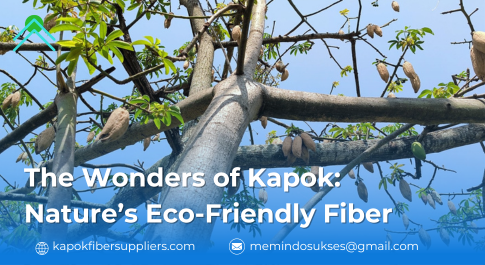
The Wonders of Kapok: Nature’s Eco-Friendly Fiber
In the world of kapok natural fibers, few materials stand out quite like kapok. Known for its lightness, buoyancy, and sustainability, this remarkable material is becoming an eco-conscious alternative to synthetic products. If you’re unfamiliar with it, you’re not alone — but it’s time to discover why kapok is gaining recognition across various industries, from bedding and insulation to eco-friendly packaging. Here’s why kapok is a fiber of the future.
What Is Kapok?
Kapok is the fiber obtained from the seed pods of the Ceiba pentandra, a tropical tree native to Southeast Asia, Central America, and parts of West Africa. The tree can reach impressive heights, sometimes soaring to over 60 meters (200 feet), and produces large, fluffy seed pods that contain the kapok fiber. The fiber is soft, silky, and surprisingly lightweight, making it ideal for a range of applications.
While kapok has been used in pillows, mattresses, and life jackets for centuries, its potential in the modern world is only beginning to be fully appreciated.
Why Kapok is Eco-Friendly
- Sustainable Harvesting
Kapok trees grow in tropical forests, often without the need for extensive farming or deforestation. They require little maintenance, and the fiber is harvested from the seed pods without harming the tree. Unlike cotton or synthetic fibers, kapok doesn’t require pesticides or heavy water usage, making it a more environmentally friendly choice. This is particularly important in an era when sustainable sourcing is increasingly valued. - Biodegradable and Non-Toxic
Kapok is 100% natural, biodegradable, and non-toxic, which makes it an excellent option for reducing plastic waste. In fact, kapok is often used as an eco-friendly alternative to synthetic fillers in cushions, bedding, and toys. Since it’s entirely natural, it breaks down naturally in the environment, unlike polyester or foam, which take decades to decompose. - Carbon Sequestration
Like other trees, kapok trees play a critical role in absorbing carbon dioxide from the atmosphere. This helps mitigate climate change by reducing the amount of carbon in the air. Their ability to grow in diverse environments further ensures that they are crucial in maintaining the ecological balance of tropical rainforests.
Key Benefits of Kapok
- Lightweight and Buoyant
One of the most distinctive features of kapok is its lightness. The fibers are hollow and air-filled, which gives them incredible buoyancy. This makes kapok a perfect filling for life jackets and flotation devices, offering an alternative to synthetic foams. Its natural buoyancy has been used for centuries to save lives, and today, it still serves as a sustainable option in aquatic safety. - Hypoallergenic
Kapok is naturally resistant to dust mites, mold, and mildew. It’s a great option for people with allergies or respiratory sensitivities. The fibers are inherently resistant to pests and fungi, which makes them ideal for bedding materials. Many people who suffer from allergies find that kapok-based pillows and mattresses are a comfortable, hypoallergenic alternative to synthetic products. - Comfort and Support
When used as a filling in pillows or mattresses, kapok offers a unique combination of softness and support. The fluffy texture provides a gentle cushioning effect, while the firm structure of the fiber ensures that it holds its shape over time. Many people who seek a more natural sleep experience prefer kapok-filled bedding because it offers a balance of comfort and spinal support.
Kapok in Modern Applications
- Sustainable Fashion
As sustainability continues to shape the fashion industry, kapok has found its place as a natural, biodegradable alternative to synthetic materials. Designers are incorporating kapok into lightweight jackets, bags, and accessories. Its softness and natural look provide a unique texture that’s also cruelty-free and eco-friendly. - Insulation and Building Materials
Kapok’s thermal insulation properties are being explored for use in building materials. Due to its natural buoyancy and ability to trap air, kapok is a highly efficient insulator. It is being considered for use in eco-friendly housing and construction, providing an alternative to more conventional, energy-intensive materials like foam and fiberglass. - Eco-Friendly Packaging
Kapok’s soft, lightweight nature makes it an ideal substitute for plastic packaging. The fiber can be used to create cushioning materials for shipping fragile items, offering a biodegradable solution to single-use plastic packing peanuts and foam. As e-commerce grows, so does the demand for sustainable packaging, and kapok offers a viable alternative to petroleum-based products.
The Future of Kapok
The future of kapok is bright as more industries recognize its environmental benefits and versatile properties. As the world moves toward sustainability, natural fibers like kapok are poised to play a significant role in reducing reliance on synthetic materials. While still somewhat niche, the demand for eco-friendly products is growing, and kapok is positioned to be a key player in the shift to a greener, more sustainable future.
By choosing kapok, consumers not only support a more sustainable supply chain but also help preserve biodiversity and reduce plastic waste. Whether in your bedding, your life jacket, or your next eco-friendly fashion purchase, kapok is a small but mighty step toward a cleaner, greener planet.
Conclusion
In a world where the consequences of our choices are increasingly being felt, turning to natural materials like kapok is a simple yet effective way to reduce our environmental footprint. Lightweight, hypoallergenic, biodegradable, and versatile, kapok is one of the most promising natural fibers available. With its growing popularity in everything from sustainable fashion to eco-friendly packaging, kapok is proving that even the softest fibers can make a big impact in the fight for a more sustainable world.
Contact us :
☎️ : +6285933133244
📍 : Jl.Ir Soekarno, No.122, Dadaprejo, Junrejo, Kota Batu, East Java 65323

[…] Sustainable Harvesting: Kapok trees grow naturally without the need for pesticides or fertilizers. The fiber is collected from seed pods without harming the tree, promoting forest conservation. kapokfibersuppliers.com […]